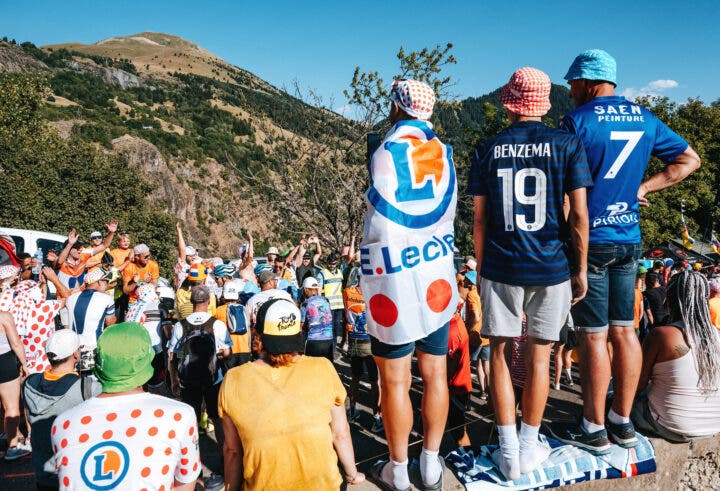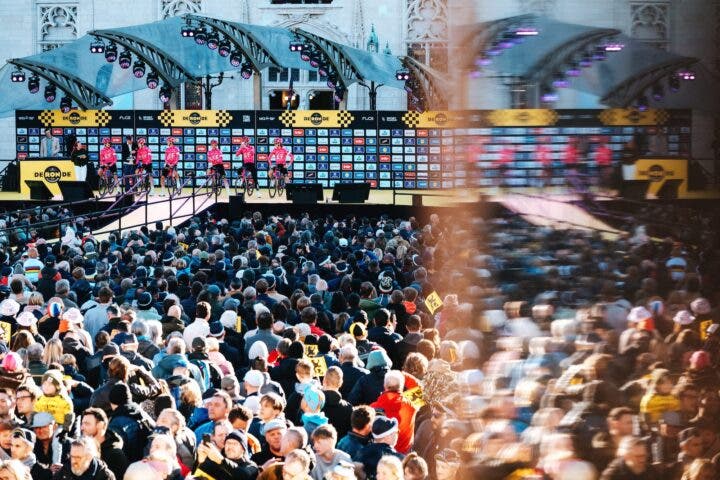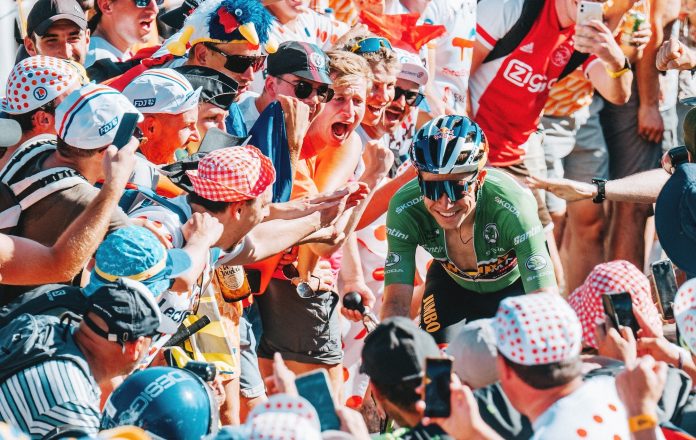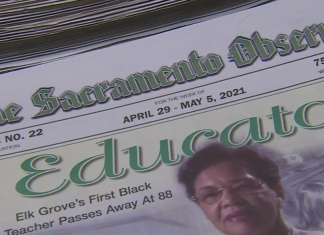Updated November 13, 2025 07:02AM
Paid admission at the Tour de France is an idea whose time will never come.
A recent podcast reignited the old notion that the Tour and other major races should start charging fans for the privilege of witnessing the world’s greatest races.
Cycling is perpetually cash-strapped, and every other sport on earth charges admission.
Why not create a new revenue stream for one of the world’s biggest free shows and share it with riders and teams?
On paper, it might make sense. In reality, the idea is sheer lunacy that betrays the very soul of what makes the Tour and racing on open roads so unique in international sport.
Anyone who’s ever posted up roadside in France or Flanders knows the thrill. Hours of anticipation, a few beers, some baguettes, maybe a barbecue, and a backpack full of trinkets from the caravan before the peloton barrels past in a blur of color, speed, and motion.
It’s not glamorous, but it is the essence of the sport.
Charging fans admission to Alpe d’Huez or the Trouée d’Arenberg — aside from a few limited VIP zones — would be logistically impossible, politically suicidal, and callously greedy. Let’s dive in.
A sport built on proximity

Part of the allure and legend of cycling is that it’s free.
Some key stakeholders hoping to modernize professional road racing may not like that, but the open-road model is what gives the sport its pulse.
Cycling fans have never paid for front-row access to see their heroes. They wait hours outside a team bus or camp out on Alpine passes just to see the two-wheeled superheroes.
It’s the world’s last truly open major sport.
Paid admission runs counter to everything road cycling stands for.
Sure, VIP tents make sense. Every major organizer — ASO, Flanders Classics, RCS — runs hospitality zones at finish lines and cobbled sectors where corporate guests pay hundreds for champagne, buffets, and big-screen TVs.
That’s fine. Selling exclusivity is a legitimate business model.
But charging the general public €10 to stand on a mountain? That’s something else entirely. It would be a gut punch to the fans and sell out the spirit of the sport.
Making the case

Insiders have been moaning for years that cycling’s business model is broken, and that’s mostly true.
All the revenue generated from a bike race — from TV rights and stage hosting fees to merchandising and public subsidies — all go directly into the coffers of the race organizers.
Cycling is one of the last major sports where the teams and players do not receive a share of the revenue.
Media reports in France estimate that ASO earned about $350 million in 2023, but almost none of that money is split with the teams.
And unlike golf or tennis, where prize money from one event can be millions of dollars, cycling is notoriously impoverished when it comes to prize purses. The men’s Tour awards about $2.5 million for three weeks of hard racing. The Tour de France Femmes avec Zwift is one-tenth that.
One idea that keeps coming up is how to convert Europe’s highest peaks and gnarliest cobbled roads — cycling’s version of a stadium — into a revenue stream to be shared with teams.
Find the best parts of a stage, fence off the final kilometers of Alpe d’Huez, for example, and charge a modest fee of $5 or $10 to get in. Many fans wouldn’t mind paying, and it’s extra dosh to spread around.
Ex-pro Jérôme Pineau brought it up in a French podcast on RMC Sport over the weekend.
“Let’s privatize the last 5 kilometers of Alpe d’Huez. Let’s charge admission, let’s have VIPs, let’s create something to make money. Historically, cycling is a popular sport, a free sport,” Pineau said. “But a free sport where there are no more riders on the road because there are only two teams [winning], Bahrain and the United Arab Emirates, is less fun, isn’t it?”
That argument goes to the heart of the argument that cycling’s “actors” — the teams and riders — don’t get a fair cut of the pie.
It’s up to teams to hustle up sponsors to pay salaries and cover the costs of fielding the team, but the race organizers keep the lion’s share of the spoils. That imbalance is part of the reason why Arkéa B&B is shuttering and Intermarché and Lotto are being forced to merge.
“Spectators come to watch the race to see your riders, but your riders don’t get paid anything. That’s what’s unfair,” Pineau said. “Hospitality areas are set up at the Tour and other major races, but it’s the organizer who takes the money, not the people who put on the show.”
Fair point. But charging fans for admission is not the right fix.
Would you pay for this?

First, let’s look at the money side. How much could the teams and riders expect to make?
Let’s say you pick five of the most exciting stages across the Tour to include paid admission zones, drawing about 20,000 paying customers at $10 each per stage, across five stages, and that’s about $1,000,000.
Maybe double that by doing it across Paris-Roubaix, Tour of Flanders, and parts of the Giro and Vuelta, bringing that total to $2,000,000.
First off, ASO would probably keep the money for themselves.
And even if it was split among the 23 teams — after expenses of building and tearing down fencing plus having staffers trying to control entry — each squad would pocket maybe $90,000 in a best-case scenario.
Is that going to change the business model in today’s super team era, when budgets are $50 million or more? Probably not.
UCI boss David Lappartient isn’t convinced, either.
“A legal framework needs to be established; charging for public space in France is complicated. And besides, I think people will ultimately want the money to go to the riders,” he told Ouest-France. “It’s not impossible, but it would be a revolution. Just look at the pension reform … So if you want to charge for the Tour de France, you’re in for a long haul.”
French roads belong to the people, and they pay a lot of taxes to make French roads among some of the best in the world. ASO pays hefty fees to the national police and local governments to close those roads each July.
Start requiring tickets, and the backlash would be immediate and passionate.
Charging admission could backfire spectacularly.
In a country where farmers block the race route every summer over fuel prices, imagine thousands of angry French cycling fans being told they need a ticket to watch the Tour roll past.
Fans might stay away, and the ones who do show up would either ignore the fences or tear them down. The gendarmes wouldn’t stand a chance.
ASO knows better

ASO, which runs the Tour and half the sport’s biggest races, understands its fans.
The Tour de France is unique in that it’s a national institution that’s deeply woven into French culture and psyche, but one that is privately owned. Race officials are always very careful to keep the public on their side.
ASO has dedicated staffers who are paid to schmooze local mayors, regional commissioners, and state politicians to keep the race close to the public centers of power (and assure that public money keeps flowing into the company’s coffers).
Every start town and finishing village shells out tens of thousands of euros each day to host a stage. No way are those politicians going to tell their voters that public money was spent on bringing the Tour de France to town, and now you have to pay $10 to see it.
There’s little upside for ASO in trying to charge the public. All those free eyeballs lining the stage every day are money signs for ASO.
The Tour already nets an estimated €40 million in annual profit for the Amaury family, a figure that’s growing steadily through global TV rights, sponsorship, and its own VIP packages.
There’s no practical way to scale the massive logistical project of charging admission on open roads. The only real option would be to cordon off the best viewing areas — finish lines, starts, the bus paddock area, the podium — and that would only agitate and alienate fans.
So why risk a political and logistical nightmare for a few extra thousand euros that would be split out with the teams?
ASO did not immediately respond when Velo reached out for comment, but it knows better than to kill the golden goose.
Free access is cycling’s biggest draw

Ask any pro what makes the Tour unique, and they’ll tell you it’s the crowds.
The scale of everything at the Tour is bigger. The pressure, the prestige, and the media, but it’s the massive crowds, sometimes 10 deep lining Alpe d’Huez, that elevate the Tour de France into one of the most iconic sporting events on the globe.
Last year’s inaugural stage over Montmartre was a massive success, arguably one of the most spectacular stages in modern Tour history.
Would that magical sense of je ne sais quoi be replicated with paid admission? Non.
Yes, cycling needs more money. Not every team has a $50 million budget. In fact, Pineau’s B&B Hotels team went down in flames because he couldn’t find more sponsors.
Is there money to be made by charging admission in a few select high-value viewing areas? Most certainly, but charging the public for access to the Tour is not the way to fix cycling’s structural problems.
Cycling’s business model might seem antiquated compared to F1 or football, but that’s also part of its charm.
In no other sport in the world can a grandparent bring their grandchildren to sit on the side of the road and watch the world’s best compete in the season’s most important event for free.
How many young pros today have a snapshot of themselves standing next to Alberto Contador or Vincenzo Nibali at a start line or outside a team bus?
That’s the soul of the sport that stretches back more than a century.
Fans wait hours for a few fleeting seconds of glory because they love the sport and the proximity to the stars that the Tour provides.
Charging admission would turn world sport’s last great public block party into another gated, elitist event.
Let’s leave bike racing alone. It’s the last free ticket in town.







